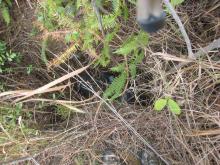Marrying from the Italian Convent
Primary tabs
A subject, which may have been covered elsewhere, as it is a part of Hong Kong’s social history, is the question of how to find a suitable European bride in the late nineteenth and early twentieth century. For young bachelors in the lower strata of European society the pool of well brought up girls was very small. But there did exist a pool of very well brought up European and Eurasian girls, who had had very little exposure to the wider world. The dilemma of ensuring that the orphans entrusted to the Italian Canossian Convent found a decent husband, who would support them and treat them as equals, rather than servants was as important for the convent as for a young unmarried man to find a good wife. In the nineteenth century the convent girls’ greatest skill was possibly in needlework, whereas later they were trained in stenography so that they could earn a wage as single women. That they were not wilting violets is evident from the example of Emma Shuster née Legg(e), https://gwulo.com/node/8996 who ran the bottling plant of the Hong Kong Brewery after the death of her husband, Edward Shuster.
People connected to my own family, who married convent girls were John Johnston Blake, who married Maria (Mary) Lyons in 1893. He was 23 - she 22. My grandmother’s half brother, John Olson jnr. married Annie Moore Burke in 1906. He was 22 - she 17. Both Blake and Olson were Protestants but that didn’t seem to be a bar. Their fathers were well established in the Colony and they themselves had good jobs. In order to improve the girls’ qualifications, the convent introduced stenography to the curriculum as well as needlework. The results of both exams were published in the newspapers. My grandmother’s nieces, Iris and Margery Warnes were placed at the convent after their parents died. When they married in the 1930s, both had jobs as stenographers but gave the convent as their home address on their marriage certificates. It was obviously an important task for the nuns to “launch” their charges into the world successfully. This subject may have been covered in Sister Teresa’s history of the convent. How did the convent ensure suitable marriages for the girls in their charge? How were meetings with young men supervised? Did the parents of a young man wishing to marry approach the convent in the first instance? – or perhaps did a married family friend, such as Mary Blake, who had been at the convent herself, make the approach in favour of a friend of her husband – in this case John Olson?
Perhaps it was on Gwulo that I read about a matchmaking procedure between Chinese families in Hong Kong, that consisted of sending the prospective couple out in a rowing boat together, whilst their parents waited anxiously on the beach. By the time they came back, the couple should have decided whether they were likely to get on or not. This was not a procedure available to the convent! I’d be grateful if anyone knows what the form was.

